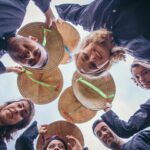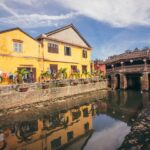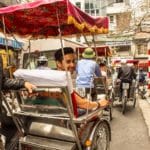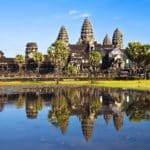Epic Cambodia to Vietnam
Southeast Asia is calling your name, and where better to start than with a deep dive into Cambodia and Vietnam? On this 23-day journey, you’ll see Wat’s up in Angkor with a full day pass into the ancient temple complex, laugh with the locals in Banteay Chhmar during a unique homestay experience, explore the markets in Siem Reap with a street food breakfast and see where the Mekong, Bassac and Tonle Sap rivers collide in Phnom Penh on a cruise at sunset. Hop over to Vietnam and see how the locals live, discover the rich history in Hoi An and taste some amazing food in Hue. Drift on the emerald waters around Cat Ba Island and go for a snoop through some of Hanoi's many markets. Enjoy unique homestays, explore national parks, eat your weight in fresh street eats and cycle through the countryside – what more could you ask for?
23 days, from
$1,419
per person
GROUP SIZE
ACTIVITY LEVEL
Details
Countries Visited:
Cambodia
Thailand
Vietnam
Accommodation: Hostel (3 nights), Guesthouse (1 night), Homestay (3 nights), Hotel (13 nights), Overnight sleeper train (2 nights)
Transportation: Boat , Overnight sleeper train , Public bus , Private minibus , Remork (Tuk-tuk)
Included Meals:
- 5 breakfasts
- 4 lunches
- 5 dinners
Group size: Minimum 1, Max 16
Minimum Age: 18
Let your mind be blown as you roam around Angkor - one of the biggest (and one of the most awesome) monuments in the world - with your leader, even catch glimpse of the temples at sunset.
Get a real taste of local life as you experience homestays in Chambok and the Mekong Delta. Get to know local families, participate in their activities and enjoy a homestyle meal.
It's taken 400 million years for Phong Nha to get this good-looking, so you'd better take advantage – you'll explore a spectacular scene of caves, underground rivers, and caverns big enough to cruise into.
You'll get on a bike in charming Hoi An - it's the best way to see the town and surrounding countryside and takes you off the beaten track, quite literally. Also, the food here? You guessed it: completely delicious
Take a boat around Lan Ha Bay with an included rice paper roll-making class while you cruise, then get up close and personal with this other-worldly landscape by kayak. Limestone karsts, blue-green waters, mysterious caves and super ancient jungle await.
Itinerary
Sawasdee! Welcome to Thailand. Your adventure begins with an important welcome meeting at 6 pm. Bangkok has so much going on if you've got time to explore, so we recommend you arrive a day or two early to explore the sights and sounds of this South East Asian hub. Why not hit the canals for a riverboat trip to Chinatown? Visit the Grand Palace and the Temple of the Emerald Buddha? Or indulge in some Thai massage? Whatever you do, be sure to sit down with a green curry or tom yum goong (spicy seafood soup) after your welcome meeting.
Rise 'n' shine, travellers! After breakfast, you'll depart Thailand and head into Cambodia – your leader will help you through the border-crossing procedures. From Bangkok to Banteay Chhmar it's an 8-hour trip, which includes time to get yourself some lunch, and the time at the border. Banteay Chhmar, which translates as Citadel of the Cat, is our destination for the evening. This charming little village is far off the tourist trail and is dotted with several temples around the area. Take a leader-led orientation walk around to get your bearings. Tonight, you'll experience traditional hospitality staying with a local family in a Khmer house set on wooden stilts. As the day comes to an end, sit down to a delicious Khmer dinner by torchlight in the grounds of the temple or at a local community centre, depending on the weather.
After a peaceful night in Banteay Chhmar, take a visit to the temple in the middle of town. Similar to many Khmer temples in Cambodia, they are surrounded by water which, most often, represents the ocean surrounding the Temple Mountain: an architectural representation of the Hindu god’s home, Mount Meru. The Temple Mountain design has influenced most Khmer temples in the Angkor period. The water also helps stabilise the building’s foundation, preventing groundwater from rising or falling too drastically. Afterwards, take a private vehicle to the city of Siem Reap (approximately 4 hours). Once you've arrived, perhaps spend some time looking around the central markets and pick up some of the delicious food on offer. Why not?
Time to visit the mighty Angkor complex with your guide. Get that camera ready, because it's going to look good, whatever the time of day. Some of this complex is over a thousand years old, going back to the days when the Khmer Empire was top dog in South East Asia. These beauties were known to represent the cosmic world and were set in perfect balance, symmetry and composition. Let your mind be blown as you roam around the site with your leader, and make sure you don’t miss the temples at sunset. The ruins are scattered over an area of some 160 square kilometres, but the main cluster of temples is close to Siem Reap, so you'll have plenty of time to get to grips with the larger-than-life Angkor Wat, the grand Bayon and the jungle-covered Ta Prohm. Tonight, have a special experience as you enjoy a traditional meal in a local family's home.
This morning, take up an awesome street food breakfast in Siem Reap’s local market. Other than this, today is free for you to experience Siem Reap however you want. If you're all templed out, but still feel like something pretty out there, you can opt for an Angkor zip-line course, which will have you soaring like an eagle over the rainforest. There’s also a landmine museum or some pretty great Urban Adventure Tours that you could book yourself in to. Your group leader will know the best things to do, so ask them if you’re stuck. If you couldn’t get enough of the Angkor site, no problems! Speak to your leader about the cheapest options, as multi-day passes are available.
Time to head to Cambodia’s capital. Take a public bus through the Cambodian countryside for around 6-7 hours until you reach the bustling city of Phnom Penh (this includes two stops). Phnom Penh sits at the junction of the Mekong, Bassac and Tonle Sap rivers, and used to be known as Krong Chaktomuk (‘City of Four Faces’), as this river junction forms an X crossing, which represents four geographic ‘faces’ of the city and surrounding area. The main centre of the city sits on the Western bank of the Tonle Sap/Mekong rivers. In the evening, don’t miss the opportunity to celebrate at a rooftop bar with views over the junction between the Tonle Sap and the Mekong.
Wake up in this bustling city and take a visit with your group to learn more about the country's history and the Khmer Rouge atrocities at the Killing Fields of Choeung Ek and the infamous Tuol Sleng Genocide Museum (S21). The rest of the day is free to explore the city. If you're in the mood for some shopping then check out the Psar Thmei (Central Market), located in an old French colonial building, for clothing or sarongs. Otherwise maybe stop by the temple of Wat Phnom, the National Museum or the French Quarter.
Travel by public bus from Phnom Penh to Ho Chi Minh City (approximately 10 hours including two border crossings and lunch). Your leader knows the drill, so they'll assist you with border crossing procedures. Arrive in Ho Chi Minh City and get your first taste of this fast-paced, fun city. Formerly known as Saigon, Ho Chi Minh City is quite the hub of markets, stalls and Vietnamese history, and much of city life happens on the streets. You'll see it's a combo of all kinds of flavours, old and new, East and West. Try a French baguette, get your pho fix, and have a caffeine hit with some Vietnamese coffee, best shared with the locals.
Today you may be required to move to a different hotel in Ho Chi Minh City for the next section of your trip. Your leader will let you know if this is the case and will help with the transfer to the next hotel. Today is a free day. You can shop for tiny ceramic tea sets at Ben Thanh Market while snacking on chao tom (barbecued shrimp paste on sticks of sugar cane). The Cu Chi Tunnels or Mekong Delta are an interesting day trip nearby – ask your leader to book you an Urban Adventure to visit.
As this is a combination trip, your group leader and the composition of your group will change at this location. There will be a group meeting to discuss the next stage of your itinerary and meet your new fellow travellers at 6pm.
Today, head down to the Mekong Delta and visit Ben Tre, where the humble coconut is everything and anything. The fertile delta is famous for its abundant harvests of tropical fruits and flowers as well as boating along the canals. On arrival, board a private boat and cruise along the maze of waterways to visit some cottage industries, where you’ll have the chance to interact with locals of the area. In the evening, head to a guesthouse along the water and enjoy some time to relax.
Rising early to the sounds of the delta coming alive, enjoy a simple breakfast before boarding a boat and catching a bus back to Ho Chi Minh City. Enjoy some free time in Ho Chi Minh City to go check out a few more sites or some tasty street food snacks. Included for today is a visit to a local market, where you can browse the exotic street foods and maybe take the chance to try some. Then finish the visit by sitting down to try the iconic Saigon café sua da (iced coffee with condensed milk) amid the market’s everyday bustle as your leader shares stories about life in Ho Chi Minh City. Late this evening, board an overnight train bound for Hoi An – a historical town on the central coast. Although conditions are basic, overnight trains are all part of the experience and the best way to travel long distances with the locals.
Arrive in Danang in the early afternoon and travel by minibus to Hoi An (approximately 1 hour). Recently declared a World Heritage-listed site, Hoi An is being beautifully restored and preserved. Known as Faifo to early western traders, it was one of South East Asia's major international ports during the 17th, 18th and 19th centuries. Today, parts of Hoi An look exactly as they did more than a century ago and it retains the feel of centuries past. It's also a shopping mecca, with much to browse and buy. Choose from original paintings, hand-crafted woodwork, ceramics, embroidery, lanterns and more. Hoi An has also become famous for its tailoring, with a great variety of tailors and fabrics to choose from. Bring your favourite piece of clothing or even just a picture, and you'll be able to have it copied. Included today is a walking tour of the Old Town, which finishes with a delicious banh mi for lunch. Afterwards, you’re free to explore Hoi An at your own pace.
There's no better way to explore the peaceful countryside of Hoi An than by bike. For a true insight into country living in Vietnam, join your leader in cycling past green rice paddies, over small creeks and through rural villages. Later in the day, you may like to cycle or catch a local bus to Cua Dai Beach near Hoi An centre for an afternoon on the stunning South China Sea. If you would like to see more of the Vietnamese countryside and visit some temples, you could book yourself into a My Son Cham day trip. The best thing is, the afternoon is yours to do as you please.
Departing Hoi An, cross the dramatic Hai Van Pass with a quick stop and photo opportunity before continuing on to Hue (approximately 5 hours including stops). As the former imperial capital of Vietnam, Hue holds the treasures of Vietnam's royal past and is a curious mix of bustling streets and tranquil settings. Your afternoon is free to go exploring. The Dong Ba market, which sells everything imaginable, is a great place to spend some time. See the Imperial Citadel, including a visit to the Forbidden Purple City, which was almost totally destroyed during the Vietnam War's Tet Offensive. In the evening, sit back, relax and enjoy a traditional dinner in a local home. These experiences off the beaten track are the ones you’ll remember.
You’ve got the whole day to explore stunning Hue. Head with your group on a street food experience in the morning to pick up a market breakfast and pass by all the local traders. Later on, you may like to take a dragon boat cruise on the Perfume River, and a visit to Thien Mu Pagoda, considered by many to be the unofficial symbol of Hue. It's an active Buddhist monastery with its origins dating back to 1601. One of the most poignant displays is a car belonging to a former monk who, in 1963, drove to Saigon and set himself alight to protest against the treatment of Buddhists by the South Vietnamese regime. Otherwise, you’ll have the opportunity to embark on an optional motorbike tour, riding with a local guide around the sights.
Jump on the bus and make your way to Quang Tri. If you’re keen, it’s just a small fee to visit the Hien Luong Bridge and Vinh Moc tunnels. Hien Luong Bridge separated the North from the South during the war. The tunnels at Vinh Moc are an expansive network of limestone tunnels that locals used as shelters from the bombing. Travel onwards to Phong Nha and spend the afternoon exploring your surroundings. You'll stay just outside Phong Nha Town, which is near Phong Nha-Ke Bang National Park: an amazing landscape full of caves and underground rivers.
Enjoy a free day to explore Phong Nha-Ke Bang National Park. At 400 million years old, this World Heritage site is the oldest karst mountain range in Asia. You might like to take a boat through Phong Nha Cave or check out the spectacular Paradise Cave. If caves aren’t your thing, chat with your leader about a kayaking adventure in Suoi Mooc. Otherwise, chill out with a coffee and soak in the river views. Later today you'll head back to Dong Hoi and hop back on a sleeper train (approximately 8 pm to 6 am) – you'll be a pro at this by now.
Arrive in Hanoi very early (approximately 5.30 am) and transfer to your hotel. Then leave your gear in a day room at the hotel. The capital of Vietnam is a charming city with over six million people. Hanoi is known for its beautiful lakes, shaded boulevards, lush public parks and its thriving Old Quarter, which is an architectural museum piece with blocks of ochre buildings retaining the air of a 1930s provincial French town. As Vietnam develops to compete with other South East Asian countries, the beautiful Hoan Kiem Lake reflects the contrasts of modern office buildings, old Buddhist temples and the tangle of ancient streets in its still surface. Take a walking tour of the Old Quarter and the French Quarter in the city with your leader. You'll visit the Dong Xuan market, the biggest wholesale market in northern Vietnam, stroll through the ancient '36 streets' where you can discover an amazing selection of shops selling everything from souvenirs to exquisite silk clothing and beautifully embroidered tablecloths. Your leader will point out some of the unique architecture around Hoan Kiem Lake and the myths and legends of the lake, and you will sample some local snacks along the way and enjoy a delicious bowl of Pho for lunch.
Leave Hanoi after breakfast around 8 am and make the drive to Sung village (approximately 4 hours). There are around 70 families living at Sung Village and the majority are Dzao ‘Tien’ people. Farming and forest plantation are their main source of income. Enjoy lunch at your homestay then take an introductory walk around the village. After getting to know the village better, take a short trek (2 kilometres) to the alluring Sung Cave and visit a 100-year-old tea plantation. The trek has some steep and slippery sections so please ensure you have suitable footwear for this activity. After a handicraft workshop, return to your homestay accommodation for a hot shower and dinner.
This morning, have an opportunity to take in more of the Vietnamese highlands on a 10 kilometre (6.2 mi) trek from Sung Village to Da Bia. The final 2 km gradually inclines and for a period of approximately 300 m there are some steps to climb, however the walk will be a steady relaxed pace. Keep an eye peeled for the monumental stone at the peak of Da Bia Mountain during the hike that takes us through the local villages, meeting people from the ethnic Muong tribe along the way. Stop for lunch at Da Bia before enjoying a scenic 1.5-hour boat cruise on Hoa Binh hydropower reservoir. Arrive at Thung Nai then board a bus transfer to Hanoi (approximately 2 hours). Arrive in Hanoi at around 6 pm. This evening is free for you to explore this delightful city. Why not relax with a bia hoi (freshly brewed draught beer) at one of the microbars in the Old Quarter?
Travel by bus and ferry (approximately 3.5 hours) to Cat Ba Island, the largest island in the World Heritage-listed Halong Bay area. With thousands of limestone islands and formations scattered around, this is one of those quintessential Vietnamese scenes where bright green water is dotted with traditional junk boats. Take a boat around Lan Ha Bay, then get up close and personal with this other-worldly landscape by kayak. There’s also the option to have a net on the side of your kayak and help the locals’ clean-up efforts. This initiative hopes to eliminate the rising amounts of plastic waste in the bay – you’ll make the locals’ day! Stay overnight on Cat Ba Island and enjoy a dip at one of the beaches and a cold beer.
Wake up in paradise, maybe starting your morning with a refreshing swim. Ensure you soak up as much sun and sand as possible, as it's back to Hanoi later in the afternoon via ferry and bus. Being such a large city, Hanoi has so much to explore. This afternoon, you could head to the French Quarter to see the European influences on parts of Hanoi’s architecture, or otherwise, get your gang together and stake out a roadside stall for some chargrilled meats or pho cuon (rice noodle rolls).
There are no activities planned for the final day and you are able to depart the accommodation at any time. With so much to see and do in Hanoi, why not book an Urban Adventure? Hanoi Street Food Experience is our pick – a 3-hour tour where you’ll get to sample amazing eats from markets, street cafes, food carts and other secret spots. If you would like to spend some more time in Hanoi, we’ll be happy to book some additional accommodation for you (subject to availability).











